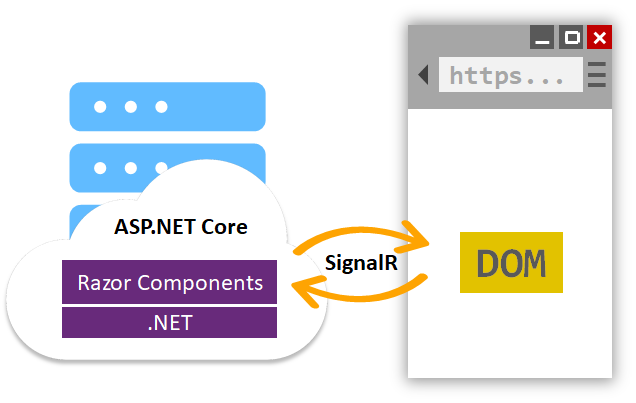Today's release of .NET Core 3 is significant. By supporting Windows desktop development and dropping support for the full .NET framework, v3 makes a statement - not only is .NET Core here to stay, but .NET Core is the future of .NET.
Included in all the fanfare is Microsoft's new web UI framework by the name of Blazor. Blazor gives us the ability to write interactive UIs using C# instead of JavaScript and it works using one of two different strategies. The first strategy compiles C# code into WebAssembly for execution directly in the browser. This WebAssembly strategy is still experimental and won't see a supported release until next year.
The second strategy sends client events to the server using SignalR. C# code executes on the server and produces UI diffs, which the framework sends back to the client over SignalR for merging into the DOM.

Most people won't see much risk in moving to .NET Core these days. Blazor, on the other hand, doesn't have a clear path to success.
Client-side development is a subjective experience. There are developers who embrace the organic JavaScript ecosystem. There are also developers who are desperate to see Blazor succeed because the messiness of working with disparate package managers, compilers, and frameworks du jour is raw and frustrating. These individuals don't necessarily dislike JavaScript, but they do feel vastly more comfortable and productive using a language like C# and tools designed to work seemlessly end to end.
These developers typically stick to building applications using server-rendered HTML because the environment is simple and productive. Yes, there is always a push to be more interactive, depending on the type of application being built, but sometimes a well-placed JS component will work well enough and avoid the complexities of building a full blown SPA.
For these teams that have avoided the Angulars, Reacts, and Vues – is now the time to jump into client UI using Blazor?

One of the first arguments against Blazor is the "look what happened to Silverlight" argument, a reference to Microsoft's last successful client UI framework. A framework Microsoft killed just as the framework was reaching peak popularity.
I personally don't consider what happened with Silverlight to have any impact on the decision to use Blazor, or not. I say this partly because Microsoft is a different company today compared to 10 years ago, but also because every Microsoft product and framework faces the same risk. Microsoft will always be inventing frameworks, then promoting and evangelizing those frameworks as the solution to all software problems. Microsoft will continue investing in those frameworks until one day, something better comes along, and suddenly, with no fanfare or formal announcement, you'll find the framework dead on the vine.
This isn't just Microsoft's history for decades, but a chronic condition of the software industry. Ask WCF customers.
The bigger risk, I think, is in the execution strategies. The WebAssembly approach, where code executes in the browser, is the solution we want to see working, but WASM is still in preview because of technical issues. When the WASM approach does arrive, we still need to evaluate how well the approach works. How much does the browser need to download? How good is DOM interop from C# code? How will the compiler work with all the evolving interfaces of the W3C? Will the development experience be as iterative as today's hot-reload experience? There's many questions to answer.

With WebAssembly on hold, we are left with the server-side execution model. But, there's something about this model that doesn't pass a sniff test. We've been told over the years that stateful web applications are evil. We've been told over the years that the network is slow, unreliable, and not to be trusted. Suddenly, Blazor enters the room and talks about storing state on the server and running click events over the network. The mind explodes with questions. Does this even scale? Can it be trusted? What happens to my mobile users in a train tunnel?
Everything about this first version is wrapped in caution tape. Everyone wants to make a prototype to see how it works. Nobody is ready to bet the farm.
Remove stateful prerendering is an innocuous title, but the implications for Blazor are considerable.
To summarize the issue – each Blazor component requires some space on the server. If you request too many components, the server can run out of space. Thus, malicious users can leverage Blazor to DOS your servers.
Issue 12245 is the type of issue that comes to mind when "run client logic on the server" is listed as a Blazor feature. How can there not be issues with security and scale?
Like with many security problems, the solution is to eliminate a useful feature. Now, you can't use Blazor to render a component that depends on a piece of state or a parameter. The only state the component can use is state the component creates once the component connects to the server.
Unfortunately, the solution eliminates many component use cases. Let's say I don't want to build a SPA. I want to add interactivity to specific pages in an app. To do so, I'll create components that can render an account by ID, or show the score for games on a specific date. With stateful prerendering it was easy to pass an ID or a date to a component and let the component go out and fetch whatever data it needs.
No stateful prerendering means there is no direct mechanism for passing parameters to a component. Components will need to dig parameters out of a URL, or use JSInterop to fetch parameters from state embedded in a page. Although both are possible, it does make some component scenarios impossible, and almost all scenarios become a bit more hacky.
In the end, I believe WebAssembly is the model we want to use with Blazor. I'm curious to see if the server-side model, with it's inherent limitations, will continue to live once WebAssembly arrives. The server model will probably be easier for developers to use, but we can already see how limitations will hinder widespread adoption.

 OdeToCode by K. Scott Allen
OdeToCode by K. Scott Allen